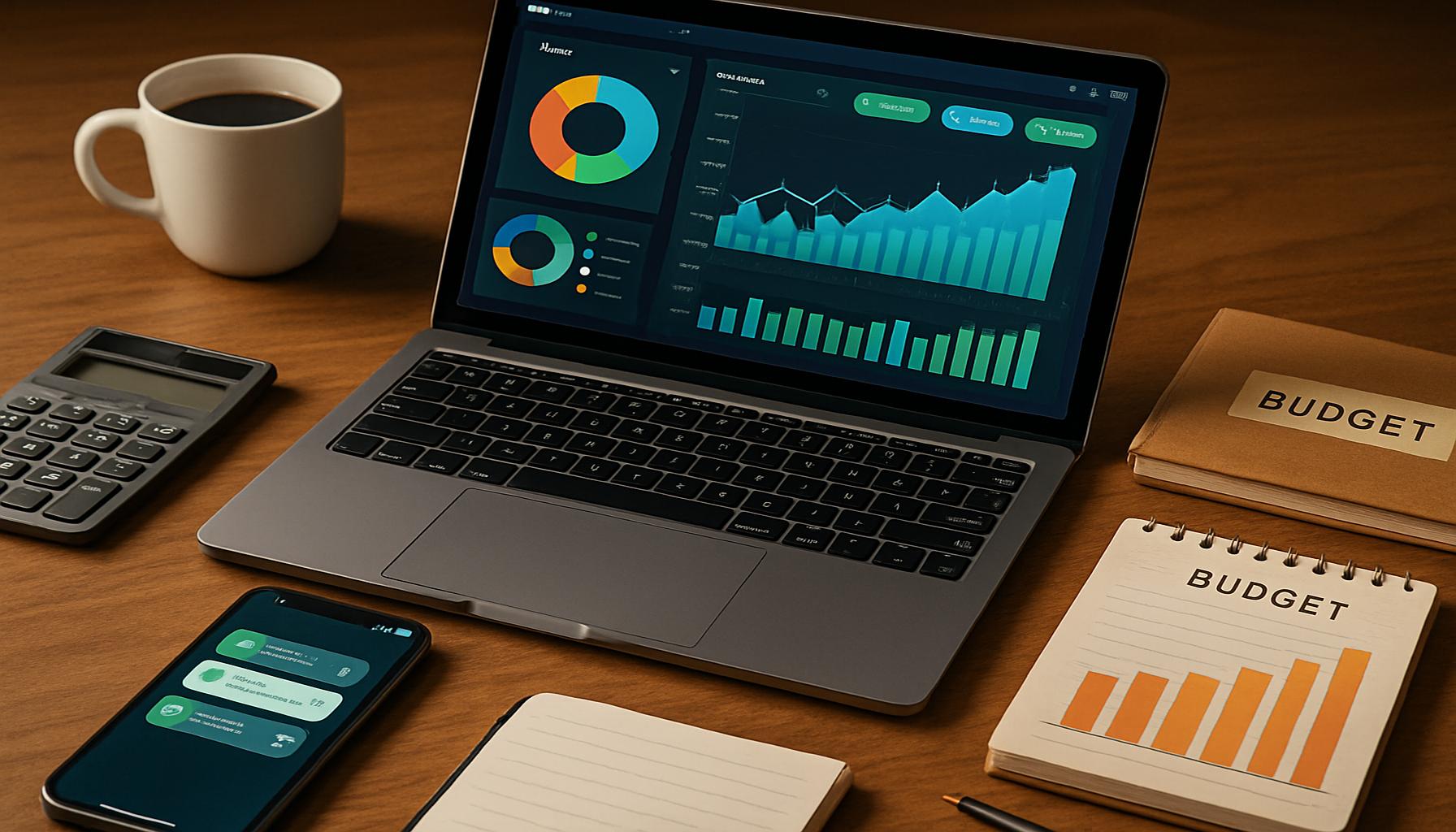Money Management in a Digital World: Tools and Apps That Transform Your Finances

Embracing Technology for Financial Management
In the age of digital innovation, the landscape of finance management has transformed dramatically. Every day, individuals are inundated with opportunities to leverage technology for better financial oversight. With a plethora of digital tools and apps readily available, managing money has evolved from a daunting task into a seamless part of daily life. Embracing these technologies is not just beneficial; it has become essential for achieving financial well-being in today’s fast-paced society.
Real-Time Tracking
Real-time tracking allows individuals to monitor their spending patterns as they happen. This immediate feedback plays a crucial role in fostering responsible financial habits. For example, spending trackers like Mint categorize purchases automatically, enabling users to see where their money goes, from groceries to entertainment expenses, all in one dashboard. Knowing how much is spent daily helps users avoid overspending and encourages sticking to a budget which, over time, can lead to significant savings.
Automated Savings
Another invaluable feature of financial technology is automated savings. Setting up automatic transfers to savings accounts can drastically simplify the process of building an emergency fund or saving for a long-term goal, such as a home or vacation. Apps like Qapital allow users to set specific rules for savings that align with their spending habits, making saving not just effortless but also fun. For example, users can set up a rule to save $1 every time they purchase a coffee, turning everyday actions into stepping stones toward significant financial goals.
Investment Management
The world of investing has also become more accessible, thanks to digital platforms that cater to investors of all levels, including beginners. Services like Robinhood and Acorns provide user-friendly interfaces and comprehensive tutorials that demystify investing. These tools empower individuals to start investing with minimal capital and with features designed to guide them through the basics of stock and fund selection, encouraging a culture of informed investing.
Diverse Resources for Varied Needs
The digital age has birthed an array of resources tailored to cater to different financial needs and preferences. For example, budgeting apps like You Need a Budget (YNAB) allow users to create personalized budgets that reflect their unique financial situations. YNAB’s method emphasizes prioritizing expenses and allocating funds proactively, effectively giving users complete control over their financial lives.
Expense trackers such as PocketGuard ensure that users are acutely aware of every dollar spent, helping eliminate the shock of over-expenditure. By connecting to bank accounts, these apps provide a snapshot of one’s financial health at a glance, making it easier to identify excess spending and modify habits accordingly.
Additionally, for those burdened with debt, tools like Undebt.it enable users to outline their debt repayment strategy clearly. These apps help visualize the path to freedom from debt by allowing users to create customized payoff plans that can be both motivating and manageable. It illustrates that with careful planning and the right resources, financial burdens can become lighter.
Concluding Thoughts
As technology continues to evolve, the potential for enhancing financial literacy and empowerment expands exponentially. Staying abreast of these innovations can unlock a wealth of knowledge, allowing individuals to make informed decisions regarding their finances and ultimately achieve a sense of financial freedom. In this dynamic environment, leveraging the right tools is no longer just an option, but a vital step towards ensuring a secure financial future.
DISCOVER MORE: Click here to find out how to earn dollars online
Transformative Financial Tools at Your Fingertips
As we dive deeper into the realm of digital finance, we uncover tools that not only streamline financial management but also enhance the way we perceive and interact with our money. These innovative tools are designed to meet diverse financial needs, making it easier for users to stay on top of their personal finances with confidence and clarity. Here’s a closer look at some of the key categories of digital financial tools that are shaping the future of money management.
Budgeting Made Easy
The first step toward financial wellness often begins with a solid budget. Budgeting apps have emerged as essential allies in this journey. Programs like You Need a Budget (YNAB) and EveryDollar allow individuals to create and manage budgets tailored to their unique circumstances. The user-friendly interfaces encourage users to assign every dollar a job, ensuring that their spending aligns with their financial goals. Some prominent features of these budgeting applications include:
- Goal Setting: Users can set savings goals and track progress over time.
- Expense Tracking: Automatic categorization of expenses makes it easier to spot trends and adjust plans accordingly.
- Reporting Features: Visual charts and graphs that provide insights into spending habits.
These tools empower users to become more active participants in their financial journeys, alleviating the stress often associated with budgeting.
Harnessing the Power of Payments
In a world increasingly leaning towards cashless transactions, payment apps have gained popularity for their ease and efficiency. Platforms such as Venmo and Cash App facilitate quick peer-to-peer transactions, allowing users to manage small expenses or split bills with friends in real-time. Moreover, many of these apps are now integrating additional financial services, such as:
- Direct Deposits: Users can have their paychecks directly transferred into their app accounts.
- Investment Features: Some platforms allow users to invest spare change from transactions, making investing accessible for everyone.
- Rewards Programs: Loyalty initiatives that reward users for frequent transactions.
This shift towards digital payment methods not only simplifies the process of handling money but also encourages users to explore other financial opportunities.
Financial Education at Your Fingertips
The role of technology in financial management extends far beyond tracking expenses and savings. Financial literacy apps such as SmartAsset and Investopedia serve as valuable resources for users seeking to enhance their financial knowledge. These platforms offer extensive content on budgeting, investing, retirement planning, and more, helping users make informed decisions. As financial literacy increases, individuals can better navigate the complexities of personal finance and avoid common pitfalls.
In essence, the variety of tools available today equips users with the resources they need to take charge of their finances. By integrating technology into daily financial management, individuals are not only enhancing their understanding of their finances but are also paving the way for long-term financial success.
DISCOVER MORE: Click here to learn how to set up your online store without inventory
Investing in Your Future: The Rise of Digital Investment Platforms
As we continue to explore transformational financial tools, we cannot overlook the impact of digital investment platforms on modern money management. Gone are the days when investing was solely reserved for the wealthy or financial experts. Today, platforms like Robinhood and Acorns are democratizing investment, making it accessible to anyone willing to invest a little, regardless of their financial background. These apps offer newcomers and seasoned investors alike multiple features that facilitate easy entry into the investment world, such as:
- Micro-Investing: Apps like Acorns allow users to invest spare change automatically from their everyday purchases, making it easier to grow a portfolio without significant upfront contributions.
- No Commissions: Many new platforms have eliminated trading fees, allowing users to buy stocks without paying a premium, which can noticeably enhance long-term returns.
- Education Resources: Many investing apps come equipped with tutorial content, helping users understand stocks, bonds, and market dynamics, bridging the gap between knowledge and investment action.
These platforms highlight how technology not only simplifies financial transactions but also opens doors to wealth-building opportunities that were previously unattainable for many Americans.
Banking and Beyond: The Era of Neobanks
In the landscape of digital finance, neobanks have begun to thrive, capturing the attention of tech-savvy consumers who seek innovative banking solutions without the fees often associated with traditional banks. Brands like Chime and Varo are reshaping customer expectations when it comes to banking, offering features that focus on consumer convenience and financial empowerment. Key attributes include:
- No Overdraft Fees: Many neobanks have redefined the concept of overdrafts by allowing users to access funds without facing hefty fees.
- Instant Transfers: These banks leverage technology to enable immediate transfers between accounts, providing users with real-time access to their money.
- Automated Savings Tools: Neobanks often come equipped with features that automatically save a percentage of deposits or round up purchases to help build savings effortlessly.
The rise of neobanks illustrates a critical shift towards consumer empowerment, focusing on user experience rather than traditional banking norms, and allowing customers to enjoy financial services that are personalized, efficient, and, importantly, more affordable.
Expense Tracking and Receipt Management
Amidst our fast-paced digital lives, remembering to keep track of every receipt or expense can feel daunting; however, receipt scanning and expense tracking apps are here to simplify that process. Applications like Expensify and Wave allow users to capture their receipts via smartphone cameras and track expenses seamlessly. These tools cater to freelancers, busy professionals, and small business owners who need to manage their finances efficiently. Notable features include:
- OCR Technology: Optical Character Recognition (OCR) helps convert the information on receipts into digital text, aiding in accurate record-keeping and expense reports.
- Integration with Accounting Software: Compatibility with popular accounting software streamlines the financial management process, syncing expenses directly into a user’s accounts.
- Collaboration Tools: For businesses, these apps often feature collaborative tools that allow team members to manage expenses collectively, improving transparency and accountability.
By embracing such technology, users can mitigate the stress of manual tracking and gain valuable insights into their spending habits, transforming their financial tracking from a tedious task into a streamlined process.
DIVE DEEPER: Click here to uncover the secrets of investing in startups
Conclusion: Embracing a New Age of Financial Empowerment
In a world where technology governs daily life, effective money management has evolved remarkably, transforming how we perceive and interact with our finances. The rise of digital investment platforms has revolutionized investing, democratizing access to wealth-building opportunities and enabling users to enter the market with ease and confidence. Simultaneously, the emergence of neobanks is redefining banking norms, focusing on consumer empowerment by eliminating traditional fees and providing tailored services that cater to individual financial needs.
Moreover, with innovative expense tracking and receipt management apps, users can effortlessly monitor their financial journeys, removing the complexities of manual bookkeeping. By integrating cutting-edge technology with user-friendly features, these tools provide unprecedented insights into spending habits and actively promote financial literacy — critical components for achieving long-term financial health.
As we navigate this digital landscape, the future promises even greater advancements, where artificial intelligence and machine learning may further personalize financial planning and investment strategies. It is vital for consumers to embrace these changes with an open mind, as this shift toward digital finance marks a significant step towards a more equitable and flexible economy. Ultimately, by leveraging the right tools and applications, individuals can take charge of their finances and pave the way for a secure and prosperous future.
Related posts:
How to Make Money in the Stock Market Without Being an Expert
How to monetize a blog and turn it into a source of income
How to Escape the Rat Race and Achieve Financial Freedom
Strategies to Live off Dividends and Become Financially Independent
Impacts of the Global Economy on Personal Investment Decisions
The Role of Money Management in Financial Stability During Economic Crisis

Linda Carter is a writer and financial expert specializing in personal finance and financial planning. With extensive experience helping individuals achieve financial stability and make informed decisions, Linda shares her knowledge on the our platform. Her goal is to empower readers with practical advice and strategies for financial success.